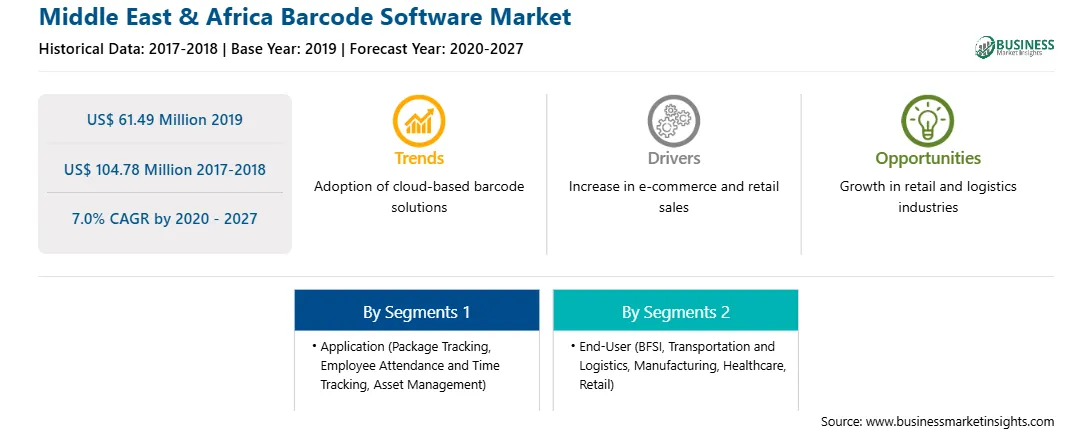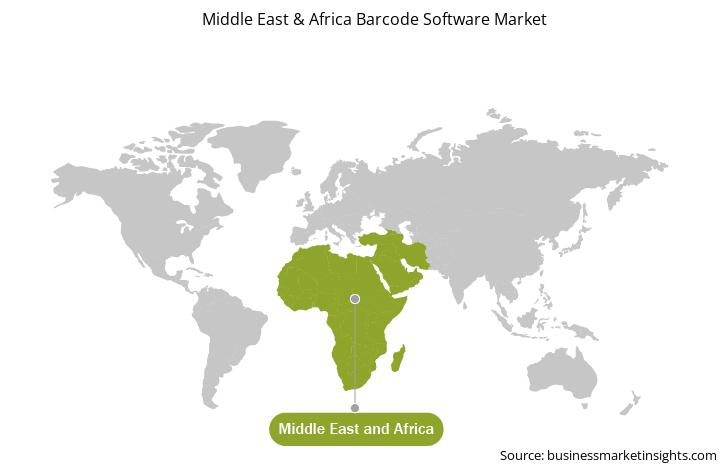Middle East & Africa Barcode Software Market
No. of Pages: 100 | Report Code: TIPRE00022746 | Category: Technology, Media and Telecommunications
No. of Pages: 100 | Report Code: TIPRE00022746 | Category: Technology, Media and Telecommunications
The MEA includes South Africa, Saudi Arabia, the UAE, and the Rest of MEA. The region is projected to witness a rapid rise in urbanization and industrialization in the coming years. Gulf countries are economically advanced, while the African countries are yet to match up to their economic conditions. Manufacturers in the Middle East countries are focusing on leveraging the latest technological developments, especially those in logistics tracking and labeling technologies, wide format printing, and expanding growth of commercial printing into the highly progressive segment of flexible packaging. In addition to the increasing disposable incomes and surging populations, the rapid procurement of smart electronic devices in the developing countries in Africa, as well as growing infrastructural developments in the MEA countries, is anticipated to contribute toward the barcode software market growth in the region. Moreover, the active involvement of the MEA countries in various global events is leading to the infrastructural development and strengthening of the economy, which, in turn, is expected to fuel the demand for barcode software in the coming years. Also, technologically advanced barcode scanning software development kits being extensively used is a major factor driving the MEA barcode software market.
The MEA includes a few high-potential countries such as Saudi Arabia, the UAE, Iran, and South Africa. As per the MENA Generation 2030 report published by UNICEF, the region is anticipated to witness a transition into its most productive years during 2018–2040 owing to the growing potential of its demographic dividend, which drives the growth and development of various sectors in the region. In addition, government initiatives such as the “Saudi Vision 2030” to boost the development of non-oil sectors, including manufacturing, healthcare, and retail, would further drive the industrial and business growth in the MEA countries. Iran, Saudi Arabia, Qatar, South Africa, and the UAE are among the worst-affected countries by the COVID outbreak in the MEA, which has hampered the economic as well as industrial growth in these countries in the past few months. However, rise in demand for mobile-based barcoding SDKs in healthcare institutes and manufacturing companies has fueled the barcode software market growth in the MEA in the past few months. The escalating need for mobile-based barcoding SDKs in the healthcare and manufacturing sectors is mainly attributed to continuous support from the respective government to improve the overall healthcare operation.

Strategic insights for the Middle East & Africa Barcode Software provides data-driven analysis of the industry landscape, including current trends, key players, and regional nuances. These insights offer actionable recommendations, enabling readers to differentiate themselves from competitors by identifying untapped segments or developing unique value propositions. Leveraging data analytics, these insights help industry players anticipate the market shifts, whether investors, manufacturers, or other stakeholders. A future-oriented perspective is essential, helping stakeholders anticipate market shifts and position themselves for long-term success in this dynamic region. Ultimately, effective strategic insights empower readers to make informed decisions that drive profitability and achieve their business objectives within the market.

| Report Attribute | Details |
|---|---|
| Market size in 2019 | US$ 61.49 Million |
| Market Size by 2027 | US$ 104.78 Million |
| Global CAGR (2020 - 2027) | 7.0% |
| Historical Data | 2017-2018 |
| Forecast period | 2020-2027 |
| Segments Covered |
By Application
|
| Regions and Countries Covered | Middle East and Africa
|
| Market leaders and key company profiles |
The geographic scope of the Middle East & Africa Barcode Software refers to the specific areas in which a business operates and competes. Understanding local distinctions, such as diverse consumer preferences (e.g., demand for specific plug types or battery backup durations), varying economic conditions, and regulatory environments, is crucial for tailoring strategies to specific markets. Businesses can expand their reach by identifying underserved areas or adapting their offerings to meet local demands. A clear market focus allows for more effective resource allocation, targeted marketing campaigns, and better positioning against local competitors, ultimately driving growth in those targeted areas.

The barcode software market in MEA is expected to grow from US$ 61.49 million in 2019 to US$ 104.78 million by 2027; it is estimated to grow at a CAGR of 7.0% from 2020 to 2027. The use of advanced and efficient barcode software has increased in the logistics and transportation, and healthcare sectors, among others. In the healthcare sector, the technology assists in ensuring enhanced patient safety and operational efficiency. The barcode technology helps organize the processes such as patient admission, identification, medication, and care. It also helps health care providers to aid correct treatment to the patients through appropriate medicines and care. In the logistics and transportation vertical, the barcode technology assists in asset tracking, stock maintenance, employee attendance, and time management. It improves supply chain management and helps companies in this sector to gain an edge over their competitors. The barcode software solutions are designed to help logistics and transportation companies in tracking shipment based on parameters such as point of origin, date, destination, and dimension. Further, the technology also assists logistics and freight operators to run operations smoothly. The technology is suitable for large as well as small and mid-size logistic firms, which fuels the barcode software market growth.
The MEA barcode software market is segmented based on application and end-user. Based on application, the market is segmented into asset management, package tracking, employee attendance and time tracking, and others. The asset management segment accounted for the largest revenue share in 2019. Based on end-user, the market is segmented into manufacturing, transportation and logistics, retail, healthcare, and others. The manufacturing segment accounted for the largest revenue share in 2019.
A few major primary and secondary sources referred to for preparing this report on the barcode software market in MEA are company websites, annual reports, financial reports, national government documents, and statistical database, among others. Major companies listed in the report are Datalogic S.P.A., DENSO ADC, Honeywell International, Inc., NCR Corporation, and Zebra Technologies Corporation.
The Middle East & Africa Barcode Software Market is valued at US$ 61.49 Million in 2019, it is projected to reach US$ 104.78 Million by 2027.
As per our report Middle East & Africa Barcode Software Market, the market size is valued at US$ 61.49 Million in 2019, projecting it to reach US$ 104.78 Million by 2027. This translates to a CAGR of approximately 7.0% during the forecast period.
The Middle East & Africa Barcode Software Market report typically cover these key segments-
The historic period, base year, and forecast period can vary slightly depending on the specific market research report. However, for the Middle East & Africa Barcode Software Market report:
The Middle East & Africa Barcode Software Market is populated by several key players, each contributing to its growth and innovation. Some of the major players include:
The Middle East & Africa Barcode Software Market report is valuable for diverse stakeholders, including:
Essentially, anyone involved in or considering involvement in the Middle East & Africa Barcode Software Market value chain can benefit from the information contained in a comprehensive market report.